Bio test 3 - Cell Mechanics
0.0(0)
0.0(0)
Card Sorting
1/233
Study Analytics
Name | Mastery | Learn | Test | Matching | Spaced |
|---|
No study sessions yet.
234 Terms
1
New cards
Plasma Membrane
Also known as the cell membrane
All cells and organelles are surrounded by a flexible membrane
All cells and organelles are surrounded by a flexible membrane
2
New cards
Organs
specialized structures in the body that perform specific life processes
3
New cards
Organelles
specialized structures inside the cell that perform specific cellular processes
often surrounded by a membrane
often surrounded by a membrane
4
New cards
Cell Fractionation
A method of separating cell parts to study their function
5
New cards
Homogenization
part of cell fractionation
disruption of cell membrane without damaging organelle
breaks the cell apart but doesn’t identify what is inside (1st step)
disruption of cell membrane without damaging organelle
breaks the cell apart but doesn’t identify what is inside (1st step)
6
New cards
Centrifuge
instrument that spins at high speeds to separate contents by density
7
New cards
List and explain the 4 methods of homogenization
1. break cell apart with **high frequency sound**
2. use **mild detergent** to make holes in plasma membrane
3. force cells through small hole using **high pressure**
4. **shear** cells between a close-fitting rotating plunger and the thick walls of a glass vessel
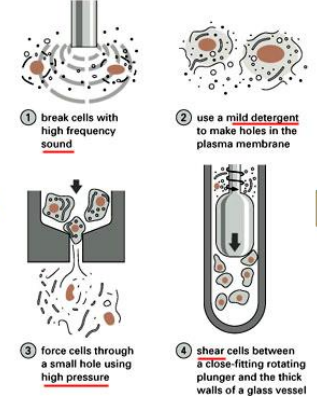
8
New cards
how does mild detergent work for homogenization
both phospholipid membrane and detergent have hydrophobi and hydrophillic properties which creates holes in membrane and membrane disintegrates
9
New cards
what is the result of homogenization called
homogenate or an extract
10
New cards
describe the homogenate
thick soup, contains large and small molecules from the cytosol, such as enzymes, ribosomes, and metabolites, as well as all the membrane bound organelles
11
New cards
does homogenization leave the membrane bound organelles intact
yes
12
New cards
what are the 2 substances in centrifugation
supernatant and pellet
13
New cards
What does the pellet contain
larger, more dense components
14
New cards
what does the supernatant contain
lighter, suspended in liquid above the pellet
15
New cards
Steps to Cell Fractionation
1. Homogenize
2. Centrifuge
* Pellet: larger, more dense components
* Supernatant: lighter, suspended in liquid above the pellet
3. Decant supernatant (the act of pouring, syphoning, or draining the top or bottom portion of a liquid)
4. Repeat centrifugation at higher speeds to separate into smaller components
16
New cards
Which centrifuged layer (supernatant or pellet) is transferred to the next fractionation step? Why?
supernatant is transferred to get smaller components of the cell in the next centrifugation
17
New cards
Which fractionation step produces the least dense organelles?
the last centrifugation
18
New cards
What is the difference between each of the centrifugation steps?
Why is this difference needed?
Why is this difference needed?
time and g force are different, they increases with every set of spins to get smaller components
19
New cards
What is in the pellet after each centrifugation
1. nuclei and cellular debris
2. mitochondria (and chloroplasts for plants)
3. microsomes (pieces of plasma membrane and cell’s internal membrane)
4. ribosomes
20
New cards
What is the Fluid Mosaic Model used to help understand
to understand membrane structure
21
New cards
Who developed the fluid mosaic model
Model developed by Singer and Nicolson (1972)
22
New cards
what does the ‘fluid’ part describe
Fluid implies movement on membrane
23
New cards
what does the ‘mosaic’ part describe
Mosaic implies that the membrane consists of many different molecules
24
New cards
Membrane Composition
Mosaic
Plasma membrane is composed of many different molecules:
* Phospholipids
* Membrane Proteins
- Integral
- Peripheral
* Carbohydrates
* Cholesterol
Plasma membrane is composed of many different molecules:
* Phospholipids
* Membrane Proteins
- Integral
- Peripheral
* Carbohydrates
* Cholesterol
25
New cards
Plasma Membrane Structure
Cell membrane made of phospholipid
Phospholipids also form the membrane around organelles
Phospholipids also form the membrane around organelles
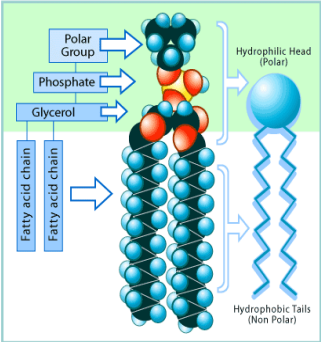
26
New cards
Phospholipid Bilayer
Bilayer = 2 layers
composed of phospholipids
composed of phospholipids
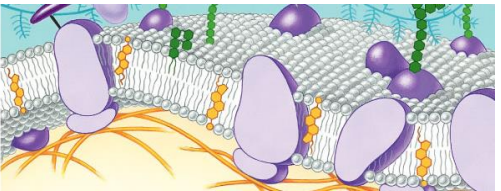
27
New cards
what is each layer called
Each layer is called a leaflet
28
New cards
amphipathic
hydrophobic and hydrophilic properties
29
New cards
Where is water in the phospholipid bilayer?
Water is on the intracellular and extracellular side
* Cell is in a water (polar) environment
* Cytoplasm (cell interior) is also a water environment
* Cell is in a water (polar) environment
* Cytoplasm (cell interior) is also a water environment
30
New cards
How are the phospholipids arranged
Phospholipid arranged so that hydrophobic tails do not face water
* Hydrophobic tails can not face outside or inside the cell
* Hydrophobic tails face inwards forming a hydrophobic core
* Hydrophilic heads face outwards
* Hydrophobic tails can not face outside or inside the cell
* Hydrophobic tails face inwards forming a hydrophobic core
* Hydrophilic heads face outwards

31
New cards
Two Types of Membrane Proteins
Integral and Peripheral
32
New cards
Integral Proteins Classification/Structural classes of integral membrane proteins
Polytopic Transmembrane
• Single-pass
• Multi-pass
Monotopic
• Single-pass
• Multi-pass
Monotopic
33
New cards
What are the two types of polytopic transmembrane integral proteins
single-pass and multi-pass
34
New cards
Polytopic
faces both sides of membrane
35
New cards
Transmembrane
spans entire phospholipid bilayer
36
New cards
Single-pass
crosses membrane once
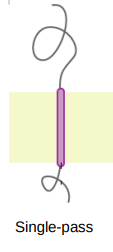
37
New cards
Multi-pass
crosses membrane several times

38
New cards
Monotopic
associated with membrane on one side (e.g. one leaflet), does not span entire bilayer
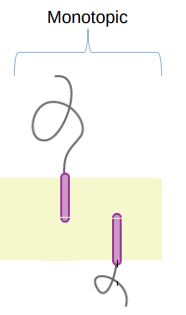
39
New cards
Integral Proteins Function
* Receptor
* Recognition
* Transport
• Channel
• Carrier / Pump
* Cell adhesion
• Anchoring
• Occluding
• Channel forming
* Recognition
* Transport
• Channel
• Carrier / Pump
* Cell adhesion
• Anchoring
• Occluding
• Channel forming
40
New cards
Receptor Protein
Has a binding site for the ligand

41
New cards
Recognition Protein
Glycoprotein: surface carbohydrate groups help identify cell (e.g. antigens)

42
New cards
Two types of transport proteins
Channel and Carrier/Pump
43
New cards
Channel Proteins
* Act like tunnels
* Molecules move through protein passively (no energy involved)
* Moves small molecules or charged ions
* Molecules move through protein passively (no energy involved)
* Moves small molecules or charged ions
44
New cards
Two types of Channel Proteins
Un-gated (leak channels): always opened
Gated (open or closed position): have open and closed conformations - Changes stimulated by changes in external environme
Gated (open or closed position): have open and closed conformations - Changes stimulated by changes in external environme
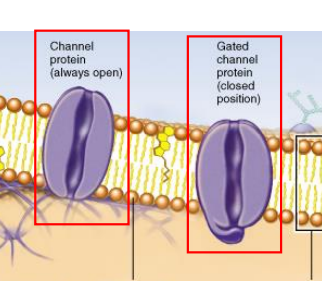
45
New cards
Carrier Proteins / Pumps
Acts like a turnstile or revolving door
Undergo conformational change to allow molecules through
Undergo conformational change to allow molecules through
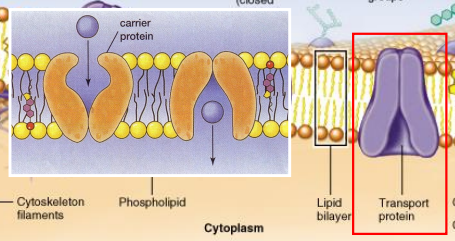
46
New cards
Difference between carrier and pump proteins
Carrier proteins are typically molecules that bind to other compounds so as to facilitate passage through a membrane. On the other hand, a pump is a protein channel that relies on a gradient (usually chemiosmotic eg electrolytes) for action. Both turnstiles
47
New cards
What is cell adhesion also known as
cell junctions
48
New cards
Cell Adhesion
Structures that connect cell to cell
Allow cells to adhere to each other
Allow cells to adhere to each other
49
New cards
Types of cell adhesion
Channel-forming junction
Occluding junction
Anchoring junction
Occluding junction
Anchoring junction
50
New cards
What are channel forming junctions known as
gap junctions
51
New cards
Gap junctions
create gaps that connect animal cells, membrane proteins from adjacent cells line up to create a channel, like 2 channel proteins
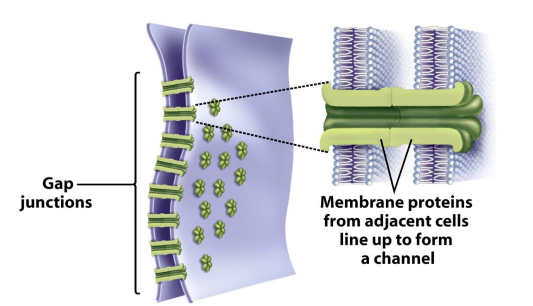
52
New cards
What are occluding junctions also known as
Tight Junctions
53
New cards
Tight junctions
Forms impermeable barrier between cells, membrane proteins create tight junctions, act like staples so that substances don’t leak in between cells
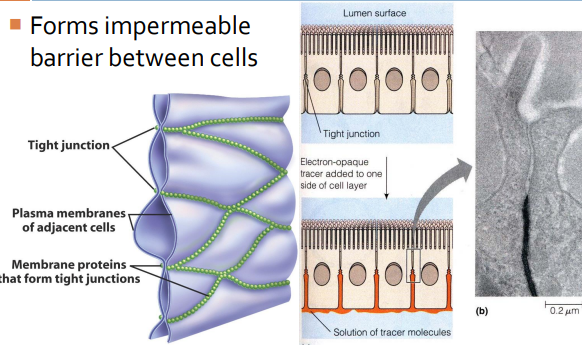
54
New cards
Where in your body, would tight junctions be crucial?
blood-brain barrier, gastrointestinal tract (need transport proteins to absorb food, it can’t go through cells, prevents pathogens from going through)
55
New cards
What are anchoring junctions also known as
Desmosome (a type of anchoring junction)
56
New cards
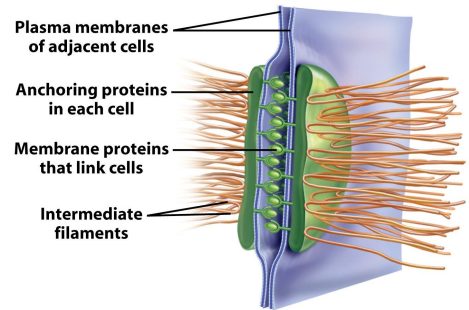
Desmosome
Desmosomes bind to desmosomes on adjacent cells
Attached to cytoskeleton
Helps resist shearing force
flexible and can move to precent ripping of cells
Attached to cytoskeleton
Helps resist shearing force
flexible and can move to precent ripping of cells
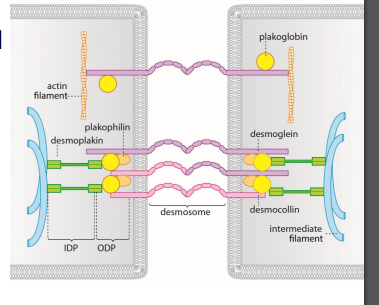
57
New cards
Peripheral Membrane Proteins
Bound non-covalently to either surface of the membrane
58
New cards
Peripheral Proteins Classification
* Extracellular
* Intracellular
* Intracellular
59
New cards
Peripheral Proteins Function
* Communication
* Structural support
* Structural support
60
New cards
Which function goes with which classification?
Extracellular - communication
intracellular - structural support
intracellular - structural support
61
New cards
Extracellular Peripheral Protein
Communication
* Located on outer leaflet and surface
* Receptor and recognition proteins (which can also be integral)
* Located on outer leaflet and surface
* Receptor and recognition proteins (which can also be integral)
62
New cards
Extracellular Matrix (ECM): Components
* A matrix of glycoproteins
* Secreted by cells
* Varies with type of tissue
* Secreted by cells
* Varies with type of tissue
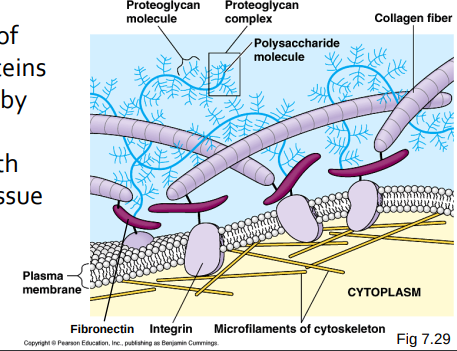
63
New cards
Extracellular Matrix (ECM): Function
Supports cell structure
Anchors cell
Separates tissues
Functions in cell signalling
Anchors cell
Separates tissues
Functions in cell signalling
64
New cards
Intracellular Peripheral Protein
Structural
* Cytoskeletal protein
* Located on inner membrane surface
* Attached to cytoskeleton of cell
* Immobilized (anchored) on membrane
* Cytoskeletal protein
* Located on inner membrane surface
* Attached to cytoskeleton of cell
* Immobilized (anchored) on membrane
65
New cards
Cytoskeleton
A network of fibers extending throughout the cytoplasm
Dynamic: can be quickly dismantled and reassembled in a new location
Dynamic: can be quickly dismantled and reassembled in a new location
66
New cards
Cytoskeleton Components
Microfilament: actin
Intermediate filament
Microtubules: tubulin
Intermediate filament
Microtubules: tubulin
67
New cards
Microfilament structure
2 intertwined strands of actin
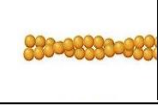
68
New cards
intermediate filament structure
Fibrous protein supercoiled

69
New cards
microtubule structure
Hollow tube of 13 tubulin columns

70
New cards
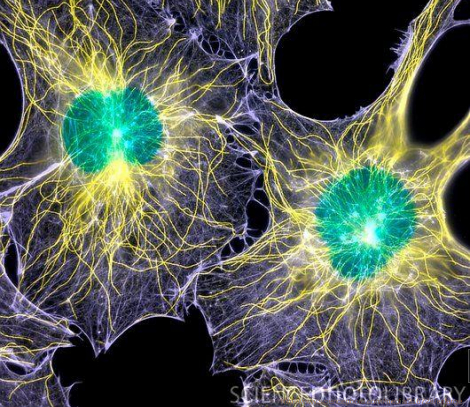
Based on the picture, where is the nuclei and where is the cytoskeleton
Nuclei (green)
Cytoskeleton: microfilaments (actin) (purple), microtubules (yellow)
Cytoskeleton: microfilaments (actin) (purple), microtubules (yellow)
71
New cards
what are the two objects that carbohydrates attach themselves to
proteins and lipid
72
New cards
where are carbohydrates found in the membrane
Glycoproteins, glycolipids
Found on Extracellular side
Found on Extracellular side
73
New cards
glycoprotein
carbohydrate + protein
74
New cards
glycolipid
carbohydrate + lipid (phospholipid)
75
New cards
What is the function of cell surface carbohydrates?
* identifies the cell (like a name) helping other cells recognize it
* acts as a signal for communication
* acts as a signal for communication
76
New cards
Of the component of the plasma membrane that was just studied, which would have an affect on the fluidity of the membrane?
* Phospholipids
* Proteins
* Carbohydrates
* Phospholipids
* Proteins
* Carbohydrates
phospholipids - depending on saturation changes fluidity
77
New cards
Membrane fluidity is affected by:
* Saturation of fatty acid
* Hydrophobic restrictions
* Cholesterol and temperature
* Hydrophobic restrictions
* Cholesterol and temperature
78
New cards
Saturation of Fatty Acid
Double bonds bends fatty acid chains preventing phospholipids from tight packing

79
New cards
How can phospholipids move in the membrane (5 ways)
lateral diffusion, rotation, swing, flexion, transverse diffusion
80
New cards
Lateral Diffusion
movement across same leaflet (phospholipids transpose with neighboring molecules)

81
New cards
Rotation
is when an individual molecule rotates quickly around its axis

82
New cards
Swing
from side-to-side
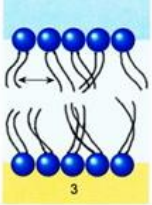
83
New cards
Flexion
contraction movement
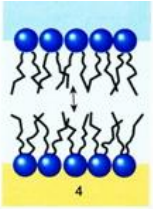
84
New cards
how do hydrophoblic restrictions affect fluidity
make the transverse diffusion rare because the polar heads have to pass through the hydrophobic tails
85
New cards
Transverse Diffusion
flip-flop
movement from one leaflet to the other
rare because because the hydrophilic head of phospholipid must go cross the hydrophobic core to get to the leaflet
movement from one leaflet to the other
rare because because the hydrophilic head of phospholipid must go cross the hydrophobic core to get to the leaflet

86
New cards
what enzyme allows for transverse diffusion
facilitated by enzyme flippase
87
New cards
Properties of Cholesterol
Large molecular size, Nonpolar
88
New cards
How does the large molecule size work in the bilayer membrane
Can interrupt intermolecular forces of attraction
89
New cards
How does the non-polar property work in the bilayer membrane
Stabilizes hydrophobic interactions
90
New cards
Explain which property of cholesterol plays a more significant role at: Low temperature
large molecule, interrupts hydrophobic interaction causing the bilayer to be flexible
91
New cards
Explain which property of cholesterol plays a more significant role at: High temperature
non-polar, stabilizes hydrophobic interactions by attracting the phospholipids making the bilayer more rigid
92
New cards
Why is it advantageous for a cell to have cholesterol?
wider range of temperatures, stops membrane from falling apart in high temps and stops from freezing at low temps
93
New cards
Is the membrane symmetrical
no, there is asymmetry
94
New cards
How is there asymmetry
Each leaflet has a different composition
Leaflet facing the intracellular side has different components compared to the extracellular side
Leaflet facing the intracellular side has different components compared to the extracellular side
95
New cards
What does an asymmetrical membrane bilayer imply
it implies that the two sides of membrane are structurally and functionally different
96
New cards
How is the asymmetry maintained
Restrictions in the transverse (flip-flop) motion help to maintain this asymmetry
97
New cards
If you were given an illustration of a cross-section of a cell membrane, describe two things that would help you identify the side that faces the outside environment.
glycoproteins, glycolipids, fibers of the extracellular matrix
98
New cards
Basic Membrane Function
* Maintain internal cell environment at a steady state regardless of changes in the external environment
* Similar to the concept of homeostasis in the human body but this is at the cellular level
* Acts as a selective barrier regulating the movement of substances into and out of the cell
* Similar to the concept of homeostasis in the human body but this is at the cellular level
* Acts as a selective barrier regulating the movement of substances into and out of the cell
99
New cards
Solute vs. Solvent
solute is what dissolves in a solvent
100
New cards
Concentration
The amount of solute dissolved in the solvent, refers to solute